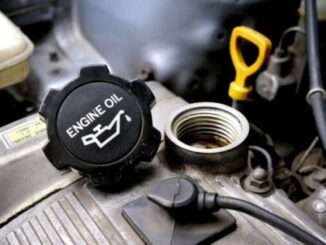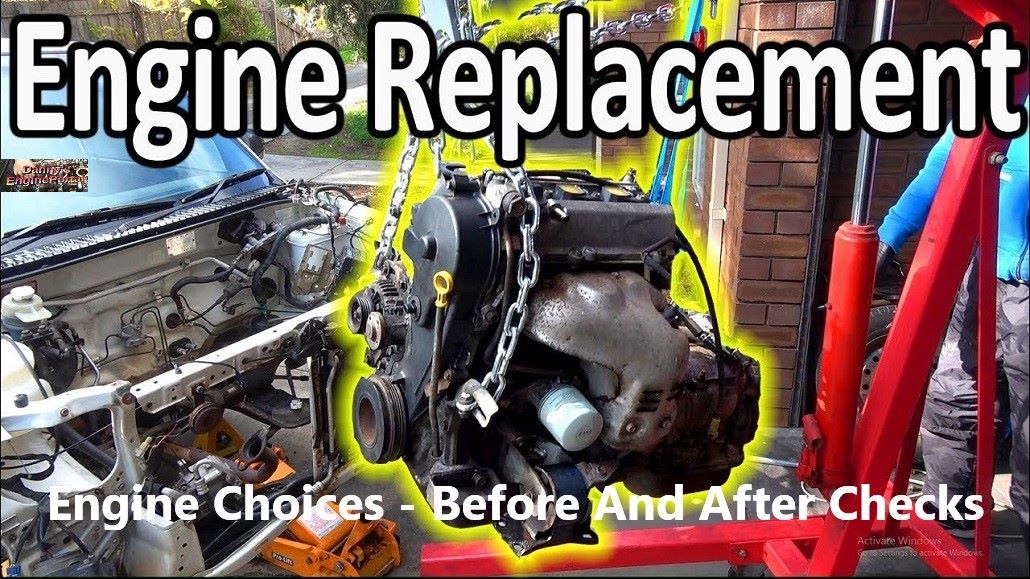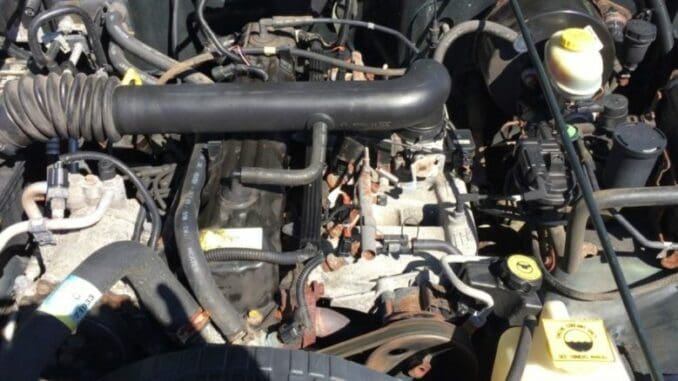
The 4 liter jeep engine, is one of AMC’s, best known engines.
So, the 4 Liter Jeep Engine, was introduced in 1986, for the 1987 model year. But, is the last in the line, of the (AMC) inline sixes.
Consequently, engineers continued to refine the engine, to reduce noise, vibration, and harshness. The 4 liter jeep engine, is regarded as one of the best Chrysler 4×4 off road engines.
Above all, the (MPI) system that debuted in 1991, is what made the 4 Liter Jeep Engine famous.
The 4 Liter Jeep Engine, has a significantly improved cylinder head. Also, a highly efficient and reliable fuel injection system. In a nutshell, the engineers at Chrysler, took a great engine and made it even better.
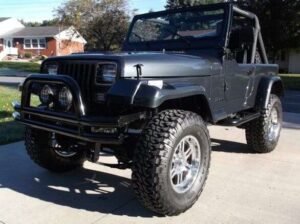
The Jeep has always had an amazingly powerful appearance. And, you can tell they mean business, just by looking at them. But, it’s not what’s on the outside, that’s most impressive about this particular Jeep.
Because, it’s actually what’s under the hood. The power, reliability, and low end torque of the 4 liter Jeep engine. And, that has made it a favorite among Jeep enthusiasts worldwide. In addition, many parts from the 2.5 engine, were interchangeable.
However, in the end it was, emission standards and worn out tooling, that brought the 4 liter Jeep engine down. So, if you are a Jeep driver, that likes to go off road, this engine could be perfect for you. And, if you invest in some, more advanced vehicle parts, that will make off-roading, even more fun.
However, the 4 Liter Jeep Engine, was discontinued, at the end of the 2006 model year.
4 Liter Jeep Engine Specifications:
- Displacement: 4.0L (242 cubic inches)
- Bore: 98.4mm (3.875 inches)
- Stroke: 86.72 87.31mm (3.414 3.4375 inches)
- Compression Ratio: 8.8:1
- Block Material: Iron
- Head Material: Iron
- 1987 90: 177 hp (132 kW; 179 PS) at 4500 rpm. And, 224 lb ·ft (304 N ·m) at 2500 rpm
- 1991 95: 190 hp (142 kW; 193 PS) at 4750 rpm. And, 225 lb ·ft (305 N ·m) at 4000 rpm
- 1996 01: 190 hp (142 kW; 193 PS) at 4600 rpm. And, 225 lb ·ft (305 N ·m) at 3000 rpm
- 2001 06: 190 hp (142 kW; 193 PS) at 4600 rpm. And, 235 lb ·ft (319 N ·m) at 3200 rpm
So, with all that good stuff going on, the 4 Liter Jeep Engine, was not without its faults.
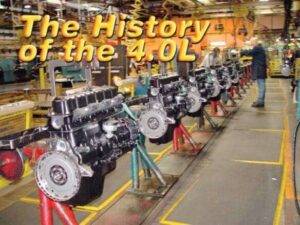
Furthermore, The 4 Liter Jeep Engine, Did Have Problems With:
- Engine Noises.
- Low Oil Pressure.
- Engine Stalling.
- Engine Misfires.
- Coolant Leaks.
- Cracked Cylinder Heads.
- Cracked and Leaking, Exhaust Manifolds.
- Piston Skirt Failures.
- Thermostat Issues.
4 Liter Jeep Engine, Cylinder Head Cracking
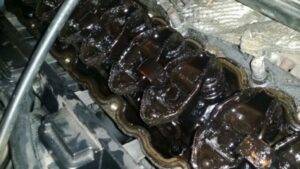
Certain years were susceptible, to cracked cylinder heads, due to casting flaws. Early 0331 head castings are, prone to cracking, causing coolant to contaminate the oil. As a result, this lead to, catastrophic engine failure. The head cracks in the center, between #3 and #4 cylinders. So, with the valve cover removed, the crack may be visible.
Exhaust Manifold, Cracks And Leaks
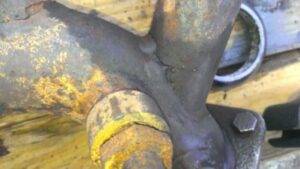
The weak point on the 4 Liter Jeep Engine, is the exhaust manifold, tends to crack. When the crack is still small, it leaks a little. But, as the manifold expands with heat, it closes up. So, when the engine is cold, you may hear, a ticking noise.
Usually, due to an exhaust leak, caused by, broken exhaust manifold bolts. Replacement of these bolts and related gaskets, is necessary to fix the condition. Also, a ticking type noise, may be noted from the engine area. And, is due to an exhaust manifold, that has cracked, where the pipes are welded.
Engine Overheating
This was a common issue, but a new thermostat seemed to cure it. Consequently, the thermostat may fail to close completely, causing the Check Engine Light to come on. This problem, will prevent the engine from reaching, normal operating temperature.
Ticking Noise, In Engine Bay (4 Liter Jeep Engine)
Duty Cycle Purge Solenoid (DCP), Causes A Ticking Sound From Engine Compartment.
The customer while sitting in the passenger compartment, may notice a ticking like sound, when the engine is idling. The sound may be more obvious, in colder ambient temperatures. Mechanical contact between the (DCP) solenoid and the body of the vehicle, may be the cause, of the tick. Consequently, the sound may appear to be similar to, the sound produced by, a worn or loose valve lifter. The cure is, Isolating the Duty Cycle Purge (DCP) solenoid, from the vehicle body.
Multiple, Engine Misfires (P0300):
The driver may experience an incident of engine misfire, during, certain vehicle operating conditions. Usually, between 50 70 MPH and, under light loading conditions. This condition is more obvious when, engine temperatures are less than 0 C (32 F). If the vehicle comes with, On Board Diagnostic (OBD), a code may also have been set. Most of the time, this will be a, Diagnostic Trouble Code (DTC) P0300 Multiple Cylinder Misfire.
Various, single cylinder misfire (DTC)’s may also be present. (4 Liter Jeep Engine)
If the frequency of the misfire is high; the Powertrain Control Module (PCM), may place the engine in “Limp In” mode.
Misfire conditions may be caused by, one or more engine exhaust valves, that are slow to close. So, late closure of an exhaust valve, may be the result of, no valve rotation and build up of carbon. This may happen when, the engine is not allowed to run at, engine (RPM)’s that are greater than 3,200 (RPM). At 3,200 (RPM) or higher, the engine exhaust valves will rotate, if not impeded by, high carbon deposits.
Consequently, high carbon deposits are related to, short trip driving. As a result, the engine is not allowed to fully warm up, to normal operating temperature. Cold temperatures will increase engine warm up times, adding to carbon deposits building up, on the exhaust valve stems. Most of the time, decarbonizing the engine is the cure.
Single Cylinder, Misfire (p0303)
A Check Engine Light may come on showing a “Cylinder #3 Misfire”. This normally, occurs in hot weather. Usually, after the vehicle has been driven, parked for ten to twenty minutes, and then restarted. Heat from the exhaust, vaporizes fuel inside the #3 fuel injector and causes the misfire. Installing an insulator sleeve, normally lowers the temperature enough, so the fuel will not vaporize.
Misfires
Due to misfires, you may experience, a loss of power when accelerating, between 50 and 70 (MPH). Also, this was more common, in colder weather. Carbon buildup on the exhaust valve stems, seems to be the issue. As a result, the exhaust valves, may close too late.
Decarbonizing the engine, seems to be the go to repair. This was most likely the cause of other problems, like noisy lifters and bent push rods. (4 Liter Jeep Engine)
Oil Pump
Oil pumps were prone to early failure, due to just wearing out.
Cracked, Piston Skirts

The pistons from ’96 onward, are all the same. The piston skirt failures, however seem to be, all around 96 2000 mark. Many think, it is just a casting flaw, in those years.
Crankshaft Position Sensor, Failure (4 Liter Jeep Engine)
Conclusion
So, that is what has made the 4 Liter Jeep Engine, A Favorite, Among Jeep Enthusiasts Worldwide.
Thank You !


